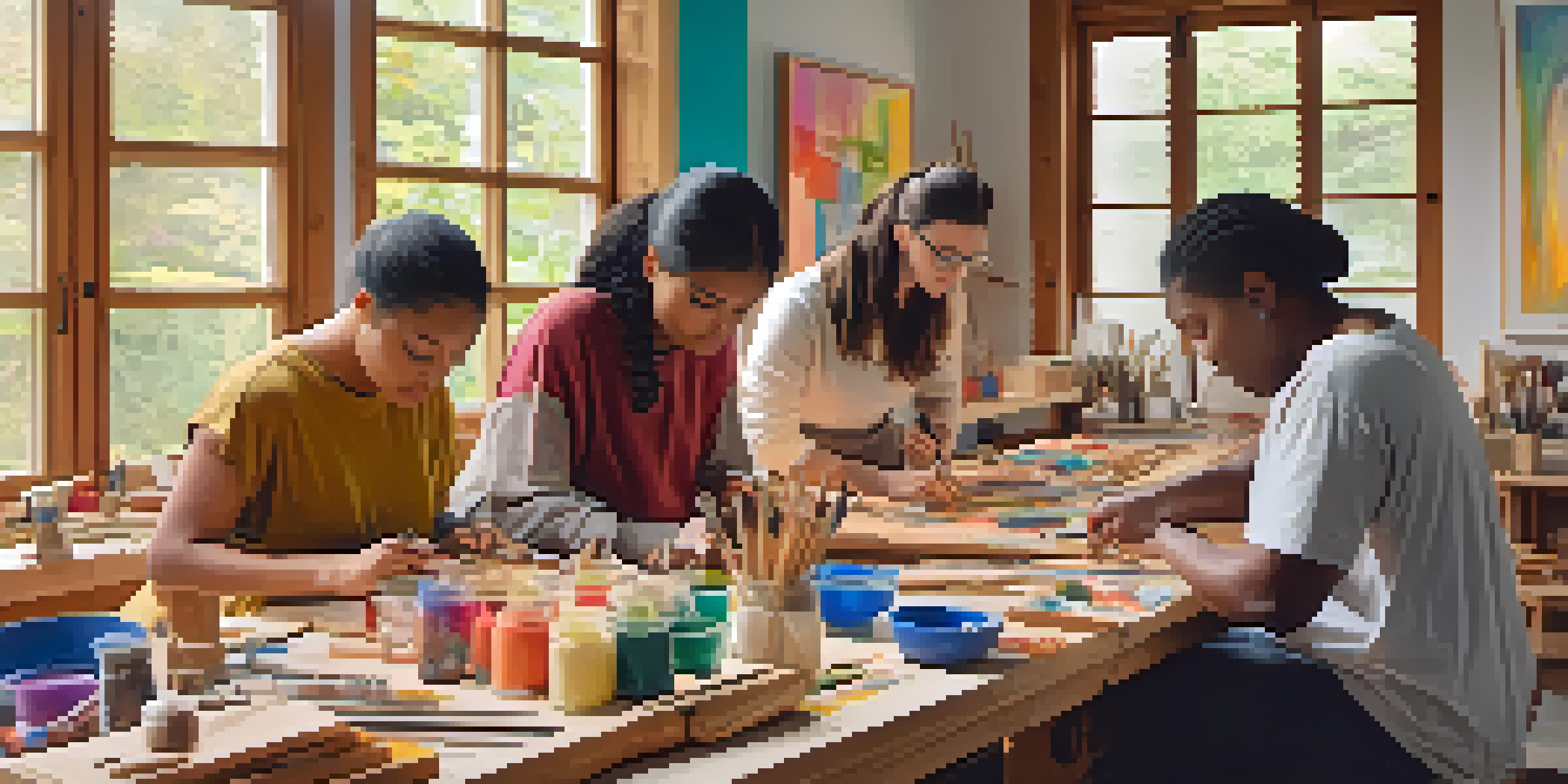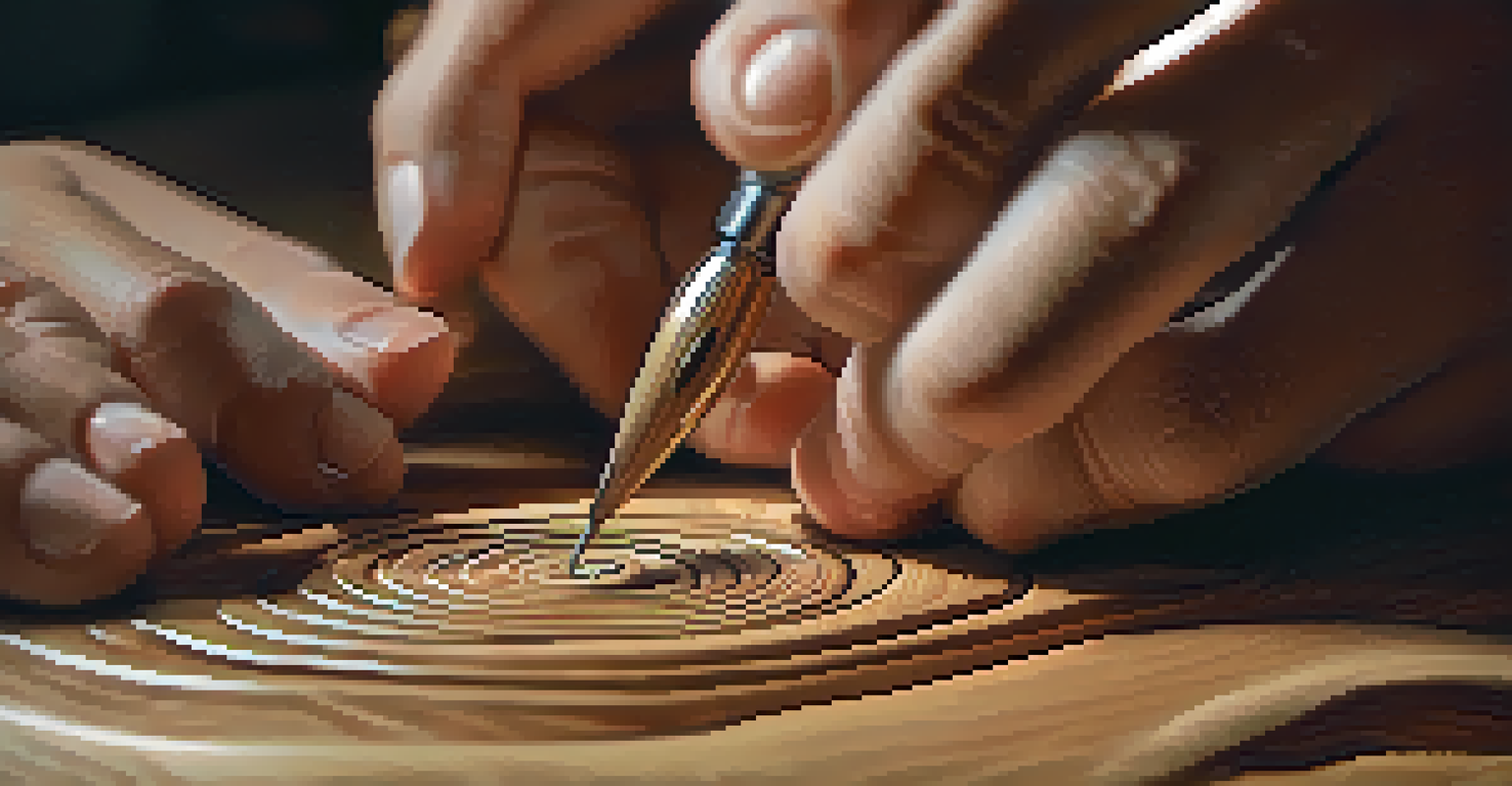Carving Techniques for Therapeutic Expression in Art Therapy

Understanding Art Therapy and Its Benefits
Art therapy is a creative approach that combines artistic expression with psychological healing. It allows individuals to communicate feelings and experiences that might be difficult to articulate verbally. Through various art forms, including carving, participants can explore emotions and promote self-discovery in a safe environment.
Art is the most beautiful of all lies; it is also the most truthful of all truths.
The therapeutic benefits of art therapy are well-documented, including reduced anxiety, improved mood, and enhanced emotional resilience. Carving, in particular, offers a tactile and physical engagement that can channel stress and facilitate mindfulness. This hands-on approach helps individuals focus their thoughts while creating something tangible and meaningful.
Moreover, art therapy can foster a sense of accomplishment and boost self-esteem. By creating art, participants often experience a release of pent-up emotions, leading to healing and personal growth. Thus, understanding the foundational benefits of art therapy sets the stage for exploring specific techniques like carving.
The Role of Carving in Art Therapy
Carving is a unique form of artistic expression that involves shaping materials like wood, stone, or clay. This technique not only allows for creativity but also serves as a powerful tool for emotional release. The physical act of carving can be meditative, encouraging individuals to focus on the present moment and their feelings.

In therapy sessions, carving can help participants explore complex emotions, such as anger or grief, by transforming those feelings into physical forms. For instance, someone may carve a figure that represents their pain, allowing them to confront and process those feelings without the pressure of words. This transformation can provide insights and lead to breakthroughs in personal understanding.
Art Therapy Enhances Emotional Healing
Art therapy, particularly through techniques like carving, promotes psychological healing by allowing individuals to express complex emotions non-verbally.
Additionally, the process of creating a carved piece can instill a sense of ownership and pride. As individuals see their projects take shape, they often feel a connection to their work that reinforces their identity and experiences. This connection can be particularly empowering in therapeutic settings.
Types of Carving Techniques in Art Therapy
There are several carving techniques that can be employed in art therapy, each offering unique benefits. Relief carving, for instance, involves carving away parts of a material to create a raised design. This technique can be particularly satisfying as it allows for immediate visual feedback and can be less intimidating for beginners.
The act of creation is a form of healing.
Another technique is subtractive carving, where the artist removes material to reveal a form. This method encourages participants to let go of excess material, symbolically representing the shedding of negative emotions or past experiences. By focusing on what to remove, individuals can reflect on what is essential to their journey.
Finally, whittling is a simpler form of carving that often uses a knife to create shapes from wood. This technique is accessible, making it great for those new to carving. It promotes fine motor skills and can be a calming activity, enhancing the overall therapeutic process.
Creating a Safe Space for Expression
A crucial aspect of art therapy, especially with carving, is creating a safe and supportive environment. Participants need to feel comfortable expressing their emotions without fear of judgment. This safety can be established through open communication and establishing ground rules at the beginning of each session.
Encouraging vulnerability is essential in art therapy. Participants should be reminded that their carved pieces are personal reflections and do not need to conform to any artistic standards. By fostering an atmosphere of acceptance, therapists can help individuals explore their feelings more deeply and authentically.
Carving Offers Unique Therapeutic Benefits
The physical act of carving serves as a meditative practice that helps participants confront emotions and fosters a sense of accomplishment.
Additionally, having the right tools and materials available can enhance the carving experience. Ensuring that each participant has access to suitable carving instruments and a comfortable workspace can significantly impact their engagement and willingness to explore their emotions through art.
Incorporating Mindfulness into Carving
Mindfulness is a key element in art therapy that promotes awareness and presence in the moment. When carving, individuals can practice mindfulness by focusing on their breath and the sensations of the material they are working with. This practice can help ground them and enhance their emotional awareness throughout the creative process.
By integrating mindfulness techniques, therapists can guide participants to pay attention to their thoughts and feelings as they carve. This awareness can lead to deeper insights and a more profound emotional connection to their artwork. For example, participants might notice feelings of frustration or joy as they work, allowing them to address these emotions directly.
Moreover, the rhythmic nature of carving can create a meditative state, fostering relaxation and reducing anxiety. As participants become absorbed in their work, they may find a sense of calm and focus that can be carried beyond the therapy session, promoting overall well-being.
Sharing and Reflecting on Carving Experiences
Sharing carved pieces in a group setting can be a powerful therapeutic exercise. Participants often find strength in discussing their creations and the emotions behind them. This sharing can foster connections and help individuals realize they are not alone in their experiences.
Reflection is another essential component of art therapy. After a carving session, participants may engage in discussions about what they created and the feelings that surfaced during the process. This reflection can lead to deeper understanding and processing of emotions, reinforcing the therapeutic benefits of the experience.
Mindfulness Deepens Creative Expression
Incorporating mindfulness in carving sessions enhances emotional awareness and promotes relaxation, enriching the overall therapeutic experience.
Additionally, therapists can encourage journaling or other forms of documentation to complement the carving experience. By writing about their feelings and insights gained during the process, participants can further solidify their emotional growth and highlight their journey of self-discovery.
The Lasting Impact of Carving in Art Therapy
The impact of carving in art therapy can extend far beyond individual sessions. By engaging in this expressive form of art, participants often develop a deeper understanding of themselves and their emotions. This newfound awareness can lead to lasting personal growth and positive changes in their lives.
Moreover, the skills learned through carving can be applied in various aspects of life, including coping strategies for managing stress and emotions. Participants may find that the techniques they practiced in therapy can help them navigate challenges outside of the art studio, providing them with tools for resilience.

Ultimately, carving in art therapy not only fosters immediate emotional expression but also equips individuals with lifelong skills. This combination of creativity and therapeutic exploration can lead to profound transformations, making carving a valuable technique within the realm of art therapy.